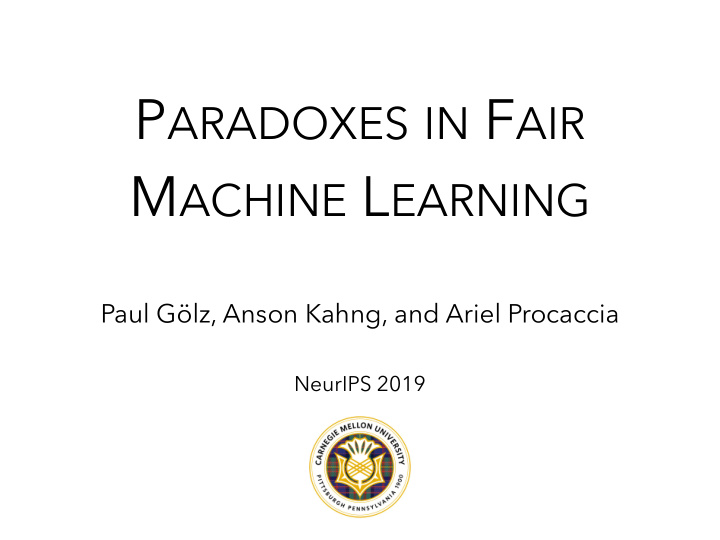



P ARADOXES IN F AIR M ACHINE L EARNING Paul Gölz, Anson Kahng, and Ariel Procaccia NeurIPS 2019
R ESEARCH Q UESTION What is the relationship between fairness in machine learning and fairness in fair division ?
R ESEARCH Q UESTION What is the relationship between fairness in machine learning and fairness in fair division ? Statistical notions of fairness Axioms of fair division (e.g., equalized odds) (e.g., resource monotonicity, population monotonicity)
R ESEARCH Q UESTION What is the relationship between fairness in machine learning and fairness in fair division ? Statistical notions of fairness Axioms of fair division (e.g., equalized odds) (e.g., resource monotonicity, population monotonicity) In order to compare these, we need the right setting.
C LASSIFICATION WITH C ARDINALITY C ONSTRAINTS Classification problem with a fixed budget of available resources to distribute: e.g., financial aid . Loans Applicants Two groups: hats and no hats Goal : maximize efficiency (fraction of loans repaid)
C LASSIFICATION WITH C ARDINALITY C ONSTRAINTS Loans Applicants Two groups: hats and no hats As a classification problem: label k applicants positively As a fair division problem: divide k loans among applicants What does it mean to be fair in each setting?
F AIRNESS C ONCEPTS S TATISTICAL F AIRNESS F AIR D IVISION A XIOMS Resource monotonicity Equalized odds Population monotonicity Demographic parity Consistency Research question (rephrased): How much does efficiency suffer if we must satisfy both equalized odds and various fair division axioms?
̂ ̂ S TATISTICAL F AIRNESS Equalized Odds (EO) : “A predictor � satisfies equalized odds with respect to a Y protected attribute � and outcome � if � and � are A Y Y A independent conditional on � .” (Hardt et al. 2016) Y � Pr( ̂ Y = 1 | A = 1, Y = 1) = Pr( ̂ Y = 1 | A = 0, Y = 1) � Pr( ̂ Y = 1 | A = 1, Y = 0) = Pr( ̂ Y = 1 | A = 0, Y = 0) “True positive and false positive rates are equal across groups”
̂ ̂ S TATISTICAL F AIRNESS Equalized Odds (EO) : “A predictor � satisfies equalized odds with respect to a Y protected attribute � and outcome � if � and � are A Y Y A independent conditional on � .” (Hardt et al. 2016) Y Pr( ̂ � Y = 1 | A = 1, Y = 1) = Pr( ̂ Y = 1 | A = 0, Y = 1) Pr( ̂ � Y = 1 | A = 1, Y = 0) = Pr( ̂ Y = 1 | A = 0, Y = 0) “True positive and false positive rates are equal across groups”
F AIR D IVISION A XIOMS Resource monotonicity : “Adding more resources makes everyone better off.” Population monotonicity : “Adding more people makes everyone worse off.” Think of these axioms as preclusions of paradoxes.
R ESOURCE M ONOTONICITY “Adding more resources makes everyone weakly better off” If the school gets more money, no one gets less allocated to them. Budget Allocations $10 $1 $1.5 $2 $2.5 $3 $1.1 $2 $3 $4 $4.9 $15
P OPULATION M ONOTONICITY “Adding more people makes everyone weakly worse off” If someone turns down aid, this can’t hurt anyone else’s allocation. Budget Allocations $10 $1 $2 $3 $4 $10 $0.9 $1.6 $2.8 $3.2 $1.5
R ESULTS (P ARTIAL L IST ) 1. In the cardinality-constrained model, we characterize the optimal allocation rule that satisfies equalized odds 2. Equalized odds and resource monotonicity are achievable with no loss to optimal EO efficiency 3. Any rule that satisfies equalized odds and population monotonicity cannot achieve a constant-factor approximation to optimal EO efficiency
R ESULTS (P ARTIAL L IST ) 1. In the cardinality-constrained model, we characterize the optimal allocation rule that satisfies equalized odds 2. Equalized odds and resource monotonicity are achievable with no loss to optimal EO efficiency 3. Any rule that satisfies equalized odds and population monotonicity cannot achieve a constant-factor approximation to optimal EO efficiency Thank you! Please come find me at poster #83.
More recommend